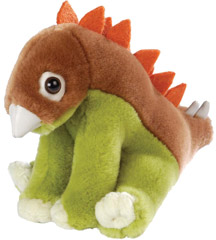The Tale of the Stegosaurus Tail
Stegosaurus is one of the most easily recognised of all the dinosaurs, with its distinctive rows of plates and the long spikes sitting on the end of its tail. Something in the region of 11 genera of stegosaur have so far been described, although strongly associated with the Morrison Formation of Utah and Colorado, recent findings in Portugal indicate that Europe had stegosaurs to. Stegosaur diversity seems to have peaked around 155-145 million years ago, at the end of the Jurassic (Kimmeridgian and Tithonian stages), although it still remains very popular today with a top five placing in Everything Dinosaur’s survey work with school children. Oddly, it seems to be more popular with girls than boys. Stegosaurus always scores higher when we break down our research data into the sexes.
Perhaps, as boys have a tendency to rate the big meat-eaters higher this may count against a herbivore like Stegosaurus in their surveys, or may be it is because the Stegosaurus soft toys we had a hand in developing have such big eyes and look so sad, that they appeal to girls more.
Soft Toy Stegosaurus – Could his appeal be down to the Sad Eyes?

Picture courtesy of Everything Dinosaur
To view a Stegosaurus soft toy and other prehistoric animal soft toys: Dinosaur Soft Toys.
In truth, with such a small head the eyes of stegosaurs were not unduly large and there is little evidence to suggest that they had excellent eyesight, superior to other dinosaurs, indeed scientists have speculated that their sense of smell was perhaps their most acute sense. Anyway, Stegosaurus remains a popular and much loved dinosaur.
Stegosaurus Tail Spikes
The debate about how effective the tail spikes could be as defensive weapons continues. Some of these tail spikes (S. armatus) could reach lengths of over 1 metre, but could they be wielded with enough force to damage a carnivore such as a 2.5 Tonne Allosaurus?
To read an Everything Dinosaur blog post about a term that was created to describe stegosaur tail spikes: Stegosaurus Tail Spikes – How They Got Their Name.
The famous American palaeontologist Robert Bakker has commented on the lack of ossified tendons (ossified tendons being a feature of many ornithopods) in stegosaurs, would this have made the tail much more flexible, enabling an angry stegosaur to swing it from side to side to deter an aggressor? However, the large dorsal plates overlap many caudal vertebrae, these plates could impend movement of the tail. The very powerful and strong forelimbs of Stegosaurus could enable it to swivel round at speed to deter any potential attacker and the strongly arched back would have enabled it to put up a formidable display, perhaps enhanced by the pumping of blood through the plates to produce an colourful “keep away from me” gesture.
A recent study of stegosaur tail spikes by McWhinney indicates that many have a high incidence of trauma related damage, does this indicate they were used in combat? The most compelling evidence for the tail spikes actually being used to strike another dinosaur was found recently when the tail vertebrae of an allosaur from the United States were studied closely. One fossil bone, shows considerable damage, it has been punctured and a cast of the wound shows that it could have been made by a Stegosaurus tail spike.
We are confident that a Jurassic predator such as Allosaurus could have found an easier meal, rather than face a 9-metre-long Stegosaurus.
It is interesting to note that the actual angle of the tail spikes is still debated. To be really effective weapons the spikes need to be positioned in a more horizontal plane then normally depicted. Most stegosaurs are illustrated with their tail spikes sitting vertically on the tail, however, recent research indicates that in at least some species, they may have been positioned to the side.
Due to Stegosaurus’s popularity there are a number of items available from Everything Dinosaur that feature this animal, there are many models and of course the soft toys, but we are pleased to see that the Dig-a-Dino range of palaeontological kits also includes a Stegosaurus. A chance for young scientists to re-enact the discovery of Stegosaurus 130 years ago.
Typical scale model of Stegosaurus: Dinosaur and Prehistoric Animal Models.






How many baby stego’s have been found? I think I have found a anchorousaurus family! Also I believe I found evidence of another stegosaurus nest family across the valley very far from place I found the first one so I think I may be living on or around the stegosaurus nesting grounds has that ever been found? I’ve found the front shoulder spike of an Ankhlyasauras magna ventress and a variety of body armor and teeth/bones. I would love to have someone come and see. I would like to get a little advice if anything. Like where I can sell some of the things I have. I found baby t-5 teeth and I don’t know for sure but I think it’s egg, a T-Rex egg. I actually have about 6 or 8 of them.
Thank you for contacting Everything Dinosaur. We suggest that you make enquiries in your local area at a school, college or university to see if there is someone who has a background in geology/fossil hunting that can take a look at your finds. You might want to enquire at your local library and get the contact details of your nearest museum with an Earth Sciences dept. As for selling such items, we strongly suggest you get advice from someone who can take a look at your finds first. When it comes to selling, depending on where you are and which country you are in, there can be very strict rules about selling fossils. For example, in the USA there are very strict rules in place about selling artifacts collected from private land.